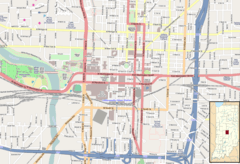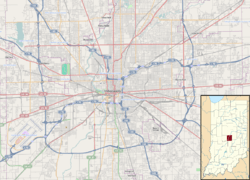Scottish Rite Cathedral (Indianapolis)
|
Scottish Rite Cathedral | |
|
The Scottish Rite Cathedral | |
    | |
| Location | 650 N. Meridian St., Indianapolis, Indiana |
|---|---|
| Coordinates | 39°46′34.07″N 86°9′28.77″W / 39.7761306°N 86.1579917°WCoordinates: 39°46′34.07″N 86°9′28.77″W / 39.7761306°N 86.1579917°W |
| Area | 1.8 acres (0.73 ha) |
| Built | 1927 |
| Built by | Hunkin-Conkey Construction Compa |
| Architect | Schreiber, George F. |
| Architectural style | Tudor Gothic |
| NRHP Reference # | 83000136[1] |
| Added to NRHP | June 6, 1983 |
The Scottish Rite Cathedral is a historic building designed by architect George F. Schreiber, located in downtown Indianapolis, Indiana, United States. It is owned by the Valley of Indianapolis Scottish Rite, an affiliated body of Freemasonry. It was built between 1927 and 1929 at the cost of $2.5 million.[2] It was built with every dimension (in feet) being evenly divisible by three (reflecting the three degrees in Freemasonry), with many being divisible by 33 (reflecting the degrees a member of the Scottish Rite can achieve).[3]
The Cathedral is one of the largest Masonic buildings, and has been described as one of the finest examples of Neo-Gothic architecture in the United States[4] The main tower features a 54-bell carillon and rises 212 ft (65 m) above Indianapolis.[5] It also has a floating ballroom.[4] Other features are patterned ceilings, ornate carved woodwork, and stained-glass windows. The auditorium has 1200 seats, and has been commended for the craftsmanship with which its fittings and decorations were made[6] It also has a large pipe organ.[7]
The main entrance, known as the Tiler's Room, is a cube of 33 ft (10 m). It features both Masonic symbols and the signs of the Zodiac.[8]
The ballroom also embodies the number 33 by being 99 feet (30 m) square, pillars defining the dancing area as 66 ft (20 m) square, and the white oak floor panels are 33 in (840 mm) square. The chandelier has 200 lights and weighs 2,500 lb (1,100 kg). The ballroom was designed in an Elizabethan architectural style.[9]
In a 1996 poll, the Indianapolis Business Journal found the Cathedral to be the most popular historic building in the city, and the second favorite building of any type. In recent years it has received 100,000 visitors a year.[10]
The Valley of Indianapolis is the only Scottish Rite Valley in the nation with an orchestra in residence, the Scottish Rite Orchestra, conducted by Ill. Jeff Warbinton, 33˚. The Orchestra was founded in 1946.
Guided tours are available on weekdays and the third Saturday of each month.
See also
References
- ↑ National Park Service (2010-07-09). "National Register Information System". National Register of Historic Places. National Park Service.
- ↑ Price, Nelson (2004). Indianapolis Then & Now. San Diego, California: Thunder Bay Press. p. 103. ISBN 1-59223-208-6.
- ↑ "Indianapolis Scottish Rite Cathedral Foundation". Indianapolis Scottish Rite. Retrieved 2011-12-29.
- 1 2 Jim Brown (30 August 2010). "Scottish Rite Cathedral: Gothic home to the world's oldest fraternity". Hello Indianapolis. Retrieved 2011-12-29.
- ↑ "Scottish Rite Cathedral". Emporis. Retrieved 2011-12-29.
- ↑ "Scottish Rite Cathedral Auditorium". ESCO Communications. Retrieved 2011-12-29.
- ↑ "Indiana State Historic Architectural and Archaeological Research Database (SHAARD)" (Searchable database). Department of Natural Resources, Division of Historic Preservation and Archaeology. Retrieved 2016-08-01. Note: This includes Harry E. Hunter (October 1982). "National Register of Historic Places Inventory Nomination Form: Scottish Rite Cathedral" (PDF). Retrieved 2016-08-01. and Accompanying photographs
- ↑ "Tour the Tiler's Room". Indianapolis Scottish Rite. Retrieved 2011-12-29.
- ↑ "Tour the Ballroom". Indianapolis Scottish Rite. Retrieved 2011-12-29.
- ↑ Shelly Swift (18 September 2000). "Funds being raised to renovate cathedral". Indianapolis Business Journal. Highbeam.com. Retrieved 2011-12-29.
Gallery
 View from south
View from south The Cathedral from the east
The Cathedral from the east The Cathedral from the War Memorial Plaza
The Cathedral from the War Memorial Plaza
External links
| Wikimedia Commons has media related to Scottish Rite Cathedral (Indianapolis, Indiana). |


